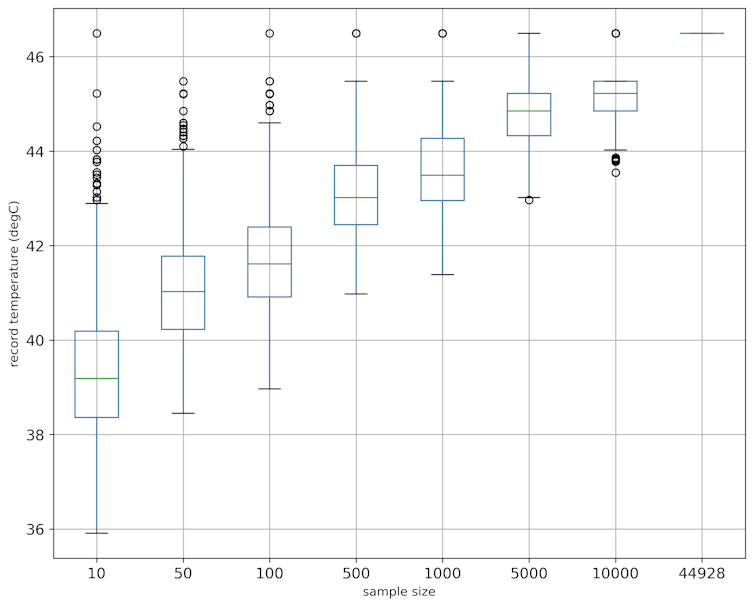Is climate change outpacing our ability to predict extreme heatwaves?
- Written by Damien Irving, Climate Data Scientist, CSIRO

When an extreme weather event happens somewhere in the world these days, it’s common to read quotes from climate scientists explaining this is exactly the kind of event we expect to see more often as climate change progresses. Such events are often devastating, but not surprising if you’ve been paying attention to the climate projections issued by scientists for many decades now.
But every so often, an event is so extreme it causes scientists to question our understanding of just how fast climate change is progressing. One such event was the heatwave across the Pacific Northwest region of the United States and Canada in the northern summer of 2021, when temperatures at some locations hit 49℃[1] (121℉) – hotter than the all-time record for Texas.
It broke heat records by such a wide margin that scientists were quoted[2] in the media[3] saying they hadn’t expected to see temperatures so high in the Pacific Northwest until much later this century.
The basic concern for these scientists was that our computer climate models are best at simulating things that span large areas and long time periods, such as the annual average global temperature (what we broadly mean when we say “the climate”). They aren’t as good at simulating smaller-scale things such as an individual storm or hot wind (that is, “the weather”).
Read more: 'Statistically impossible' heat extremes are here – we identified the regions most at risk[4]
It’s not that our models can’t simulate small-scale weather – they’re basically the same models we use for weather forecasting – it’s just very computationally expensive to have them zoom in and run in “weather mode” to get a highly detailed simulation. It’s feasible for a seven-day weather forecast, but not for a century-long climate simulation.
Given this limitation, the scientists quoted in the media were concerned extreme weather events might be more sensitive to climate change than our models suggest.
Quantity matters too
While these concerns around the quality of our model simulations at weather-relevant scales are valid, what’s often overlooked is the quantity of model simulations involved. Given the natural variability in the climate system, scientists prefer not to rely on just one model simulation when making climate projections. Instead, they run a range of century-long simulations – from just a handful up to 50 or more for the most well-resourced modelling groups – and look at the range of possible outcomes.
For climate metrics such as the annual average global temperature, that’s enough simulations to capture the full range of possibilities. It’s a value that doesn’t vary much from year to year because it’s an average over the entire globe, so the climate change signal dominates over natural variability. To use a slightly more technical term, we say it has a high “signal-to-noise” ratio.
In contrast, the weather can vary greatly over relatively short time frames, and therefore has a very low climate signal-to-noise ratio. Something like the hottest day of the year at a given location is especially noisy, because small variations in the alignment of weather patterns can make all the difference between a regular hot day and a record-shattering one.
In this situation, many more simulations would be required to reliably estimate the upper limit on what extreme temperatures are possible.
Read more: "Weather" and "climate" are used interchangeably. They shouldn't be[5]
How many simulations are enough?
To try and understand how many model simulations would be needed, our recently published research[6] used a climate model to simulate 45,000 years’ worth of daily weather at Seattle-Tacoma airport in the Pacific Northwest.
We then went through a process of picking out 1,000 random samples of 100 years of data from this population of 45,000 years, then 1,000 samples of 500 years, 1,000 years, 5,000 years, and so on. For each sample, we wrote down the maximum daily temperature we found (that is, the record temperature produced in each of these sample simulations).
To our surprise, as the samples got bigger, the record temperatures we found showed little evidence of stabilising. They just continued to grow, indicating even samples spanning several thousand years are insufficient to capture the full range of possible extreme temperatures.
The reason we kept finding hotter days as the sample size grew is that the larger samples included more weather patterns. This meant there was a greater chance of producing a unique pattern with the near-perfect alignment of weather systems to generate even more heat at our fixed location. It turns out the weather patterns that produce the most extreme heat are very unique – and indeed far rarer than we’d expected.
Luck of the draw
From this perspective, the record-shattering heat experienced in the Pacific Northwest in 2021 was due not just to the overall trend of global heating, but also to the random shuffling of the weather. And our research suggests the latter factor plays an even larger role in this type of event than many climatologists had suspected.
This means that even though the Pacific Northwest heatwave broke records by such a wide margin, that is not necessarily a sign climate change is happening faster than expected, or that our models are doing a bad job of simulating how climate change increases the likelihood of extreme heatwaves.
It could simply be that our sample sizes are too small. If we had run more model simulations we could have simulated the right chance alignment of weather to generate a record-shattering day, meaning this real-life heatwave wouldn’t then have outstripped climatologists’ predictions to such an extent.
Read more: The North American heatwave shows we need to know how climate change will change our weather[7]
Advances in supercomputers have traditionally been used to run climate models at higher resolution (that is, to zoom in and get closer to “weather mode”). But when it comes to predicting just how extreme the weather can get in a warming world, we might get more bang for our buck by using those advances to run many more simulations as well. That will show us what kind of extreme heat is possible as a rare event now, and what will be more commonplace in the coming decades.
References
- ^ hit 49℃ (www.climatehubs.usda.gov)
- ^ quoted (edition.cnn.com)
- ^ media (www.nationalobserver.com)
- ^ 'Statistically impossible' heat extremes are here – we identified the regions most at risk (theconversation.com)
- ^ "Weather" and "climate" are used interchangeably. They shouldn't be (theconversation.com)
- ^ recently published research (doi.org)
- ^ The North American heatwave shows we need to know how climate change will change our weather (theconversation.com)
















